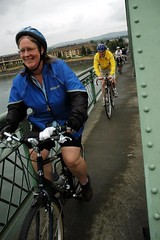
several others) has been denied.
(Graphic: City of Vancouver).
A request by the City of Vancouver to add directional pavement markings and signage on the I-5 bridge pathway has been denied by the Oregon Department of Transportation. We shared details on this project back in September 2009 and ODOT made their decision last month.
Senior Transportation Planner with City of Vancouver Jennifer Campos has been working on a host of improvements to make the existing I-5 bridge crossing easier and safer to bike and walk over. Since the Washington DOT’s jurisdiction of the bridge ends on the north side of the river, Campos needed ODOT approval for the new markings and signs.
“To allow use of these markings without the necessary approvals and properly documented implementation criteria would put us in a very awkward position from a liability perspective.”
— Dennis Mitchell, ODOT Region 1 Traffic Engineer
Campos enlisted the help of consultants to come up with a plan for the markings which would have been similar in design to those installed by Multnomah County (and still currently being used) on the Hawthorne Bridge.
Campos had to request permission to use the pavement markings and signage because they are non-standard and they are not included in the Manual on Uniform Traffic Control Devices. To bolster her case to ODOT, Campos submitted many supportive comments, including a letter of support from the Washington DOT. But ODOT was not swayed.
Campos heard a reply from ODOT’s Region 1 Traffic Engineer Dennis Mitchell via email on May 11, 2010. Here’s an excerpt from that email:
“We appreciate your concerns and efforts in collecting the pertinent/supportive information; however we also hope that you can understand that we are obligated to comply with our traffic control device standards (federal, state and local)… After considering all of the factual and antidotal [sic] information, we have to deny your request for the proposed directional bike markings on the Interstate Bridge shared use sidewalks.”
One of the purposes of the markings was to encourage biking and walking traffic to travel in the same direction as motor vehicle traffic (meaning north on the eastside path and south on the westside path). But, as Campos made clear in our story in September, the markings would have only suggested and not required one-way directional riding.
Even so, ODOT’s Mitchell didn’t seem to like the one-way implications of the markings. He pointed to biking and walking traffic counts that showed a majority of bike traffic goes in the opposite or “contra-flow” direction to motor vehicle traffic. (Bike counts on the path as performed by the Columbia River Crossing study showed that during a 14 hour period (from 6:00am to 8:00pm) on a weekday in September 2007, there were a total of 237 people who biked and walked on the west side of the bridge and 131 people on the east side).
Here’s the snip from Mitchell’s email on the directional riding issue:
“With the large numbers of contra-flow bicycle riders it isn’t practical to change the travel patterns to one-way on each sidewalk for bicycle riders. Experience has shown it is impossible to change travel patterns (behaviors) with signs and or markings when the majority of bicycle riders currently are riding in the contra-flow directions. This more often results in more disrespect for the signing and markings.”
Back in September, Campos said,
“There has never been any discussion about making the directional riding a mandatory requirement, only suggestive as I know there are many cyclists who do not feel comfortable riding on the east side span.”
Interestingly, Mitchell also pointed out that comments on BikePortland influenced his decision, “The majority of the blogs were opposed to the proposed directional markings.”
Regardless of the directional riding issue, the main reason for denial comes back to standards. Like the City of Portland has had to deal with in their use of bike boxes, non-standard markings that are not specifically approved by state and federal authorities come with a certain level of risk for municipalities that use them. Or, as Mitchell put it:
“As you are aware the special markings as proposed are not in the current or 2009 standards and as a result have no legal basis for use in Oregon. To allow use of these markings without the necessary approvals and properly documented implementation criteria would put us in a very awkward position from a liability perspective.”
Campos said that while their signage plan will not move forward, they’ve continued with other bridge access improvements like new kiosks at both ends of the bridge, widening of the path that leads up to the bridge in the southbound direction, installing a dedicated left-turn pocket for bike traffic to access that pathway, and restriping of the parking lot on the east side of the bridge (on the Vancouver side) to discourage cars from blocking bridge access when they park.


